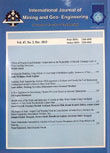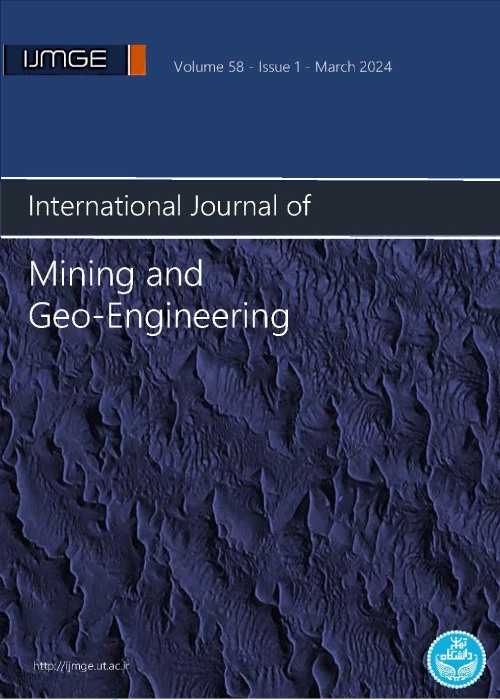فهرست مطالب

International Journal of Mining & Geo-Engineering
Volume:49 Issue: 1, Winter and Spring 2015
- تاریخ انتشار: 1394/04/26
- تعداد عناوین: 7
-
-
Pages 1-18This study deals with the 3D recovering of magnetic susceptibility model by incorporating the sparsity-based constraints in the inversion algorithm. For this purpose, the area under prospect was divided into a large number of rectangular prisms in a mesh with unknown susceptibilities. Tikhonov cost functions with two sparsity functions were used to recover the smooth parts as well as the sharp boundaries of model parameters. A pre-selected basis namely wavelet can recover the region of smooth behaviour of susceptibility distribution while Haar or finite-difference (FD) domains yield a solution with rough boundaries. Therefore, a regularizer function which can benefit from the advantages of both wavelets and Haar/FD operators in representation of the 3D magnetic susceptibility distributionwas chosen as a candidate for modeling magnetic anomalies. The optimum wavelet and parameter β which controls the weight of the two sparsifying operators were also considered. The algorithm assumed that there was no remanent magnetization and observed that magnetometry data represent only induced magnetization effect. The proposed approach is applied to a noise-corrupted synthetic data in order to demonstrate its suitability for 3D inversion of magnetic data. On obtaining satisfactory results, a case study pertaining to the ground based measurement of magnetic anomaly over a porphyry-Cu deposit located in Kerman providence of Iran. Now Chun deposit was presented to be 3D inverted. The low susceptibility in the constructed model coincides with the known location of copper ore mineralization.Keywords: Magnetic anomaly, Sparsity constraints, Wavelet transform, 3D modeling
-
Pages 19-32This paper tries to determine an optimum condition for the flotation operation of the Alborz-Sharghi coal washing plant. For this purpose, a series of comprehensive experiments have been conducted on representative samples from feed of the flotation system of the plant. Four operational variables such as the collector dosage (Fuel oil), the frother dosages (MIBC), the pulp density percent and the impeller speed were taken into account. After obtaining representative samples, 81 required experiments were designed using the orthogonal array (34) of Taguchi method. Three levels of the variables amount including low, base and high were considered for the experiments. The most obvious finding to emerge from this study was that the optimum flotation recovery (61.09 %) is obtained in the base level (L-2) of the collector dosage, the lowest level (L-1) of MIBC and the highest levels (L-3) of the pulp density and the impeller speed. The sensitivity analysis of the variables also indicated that the increase in the collector dosage causes to increase in the total recovery of the flotation and the coal quality. Besides, the largest effect on total recovery was clearly related to the pulp density levels. The increase in values of the pulp density causes to decrease in the recovery values.Keywords: Flotation system, Operational variables, Optimum recovery, Alborz, Sharghi coal washing plant
-
Pages 33-45Clay minerals are considered the most important components of clastic reservoir rock evaluation studies. The Shurijeh gas reservoir Formation, represented by shaly sandstones of the Late Jurassic-Early Cretaceous age, is the main reservoir rock in the Eastern Kopet-Dagh sedimentary Basin, NE Iran. In this study, X-ray diffraction (XRD), X-ray fluorescence (XRF), scanning electron microscopic (SEM) studies, and thermal analysis including differential thermal analysis (DTA), and thermogravimetric analysis (TGA) techniques were utilized in the characterization of the Shurijeh clay minerals in ten representative samples. The XRF studies showed that silica and aluminum oxides are present quantities. The XRD test was then used to determine the mineralogical composition of bulk components, as well as the clay fraction. The XRD patterns indicated the presence of dominant amount of quartz and plagioclase, with moderate to minor amounts of alkali feldspar, anhydrite, carbonates (calcite and dolomite), hematite and clay minerals. The most common clays in the Shurijeh Formation were illite, chlorite, and kaolinite. However, in very few samples, glauconite, smectite, and mixed layer clay minerals of both illite-smectite and chlorite-smectite types were also recognized. The XRD results were quantified, using the elemental information from the XRF test, showing that each Shurijeh exhibited low to moderate amounts of clay minerals, typically up to 21%. The amount of illite, the most dominant clay mineral, reached maximum of 13.5%, while the other clay types were significantly smaller. Based on the use of SEM and thermal data, the results of the identification of clay minerals, corresponded with the powder X-ray diffraction analysis, which can be taken into account as an evidence of the effectiveness of the thermal analysis technique in clay typing, as a complementary method besides the XRD.Keywords: differential thermal analysis (DTA), Shurijeh formation, thermogravimetric analysis (TGA), X-ray fluorescence (XRF), X-ray diffraction (XRD)
-
Pages 47-56Previous case histories have shown that soil liquefaction severely damaged many structures supported on pile foundations during earthquakes. As a result, evaluating the potential for instability is an important consideration for the safe and resistant design of deep foundation against earthquakes. In this study, the liquefaction susceptibility of saturated sand interacting by single concrete pile was simulated by means of finite difference method. A nonlinear effective stress analysis was used to evaluate soil liquefaction, and the soil-pile interaction was considered using interface elements. The parameter Ru was defined as the pore water pressure ratio to investigate liquefaction in the soil mass during time. A set of numerical models were carried out by three types of soil mass with various condensation (loose, semi-dense and dense) under three ground motion with different predominant frequencies and peak accelerations. The effect of these parameters was studied using excess pore pressure, lateral movement and settlement time histories. It was found that the pile can affect the liquefaction susceptibility of soil by comparing the near pile and free field responses. However, for various soil and earthquake characteristics, it was found that the depth of soil liquefaction and triggering, varies.Keywords: dynamic behavior of pile, excess pore pressure ratio, liquefaction susceptibility, soil, pile interaction
-
Magnetic susceptibility as a tool for mineral exploration (Case study: Southern of Zagros Mountains)Pages 57-66Magnetic susceptibility has been extensively used to determine the magnetic properties of rocks for different applications, such as hydrocarbon or mineral explorations. This magnetic quantity can be directly measured in an accurate but time-consuming operation, or it can be mathematically approximated using a reliable procedure to achieve a desired accuracy. The Poisson theory is one of the most well-known approaches which provide a meaningful relationship between the earth’s gravity and magnetic fields to derive the magnetic susceptibility. In this approach, the reliability and efficiency of the derived magnetic susceptibility depends on the method of computation of the gravity gradient tensor. We investigated two different methods of determination of gradient tensor; different distance method and Fourier transform technique. From the investigation, the Fourier transform method was more consistent with the geological features which led to more reliable information required for mineral explorations. The performance of the Poisson theory, the different distance method, and the Fourier transform was investigated in the coastal Fars, in Iran. This was highly disposing for geological and mineral features. Salt domes in the study area were detected and results compared with the available geological map.Keywords: fourier transforms, gravity gradient tensor, magnetic susceptibility, salt glacier
-
Pages 67-74To enhance the certainty of the grade block model, it is necessary to increase the number of exploratory drillholes and collect more data from the deposit. The inputs of the process of locating these additional drillholes include the variogram model parameters, locations of the samples taken from the initial drillholes, and the geological block model. The uncertainties of these inputs will lead to uncertainties in the optimal locations of additional drillholes. Meanwhile, the locations of the initial data are crisp, but the variogram model parameters and the geological model have uncertainties due to the limitation of the number of initial data. In this paper, effort has been made to consider the effects of variogram uncertainties on the optimal location of additional drillholes using the fuzzy kriging and solve the locating problem with the genetic algorithm (GA) optimization method.A bauxite deposit case study has shown the efficiency of the proposed model.Keywords: additional drillholes, extension principle, fuzzy variogram model, geostatistics, kriging
-
Pages 75-81The estimation of metallurgical parameters of flotation process from froth visual features is the ultimate goal of a machine vision based control system. In this study, a batch flotation system was operated under different process conditions and metallurgical parameters and froth image data were determined simultaneously. Algorithms have been developed for measuring textural and physical froth features from the captured images. The correlation between the froth features and metallurgical parameters was successfully modeled, using artificial neural networks. It has been shown that the performance parameters of flotation process can be accurately estimated from the extracted image features, which is of great importance for developing automatic control systems.Keywords: froth flotation, image analysis, metallurgical parameters, process control


